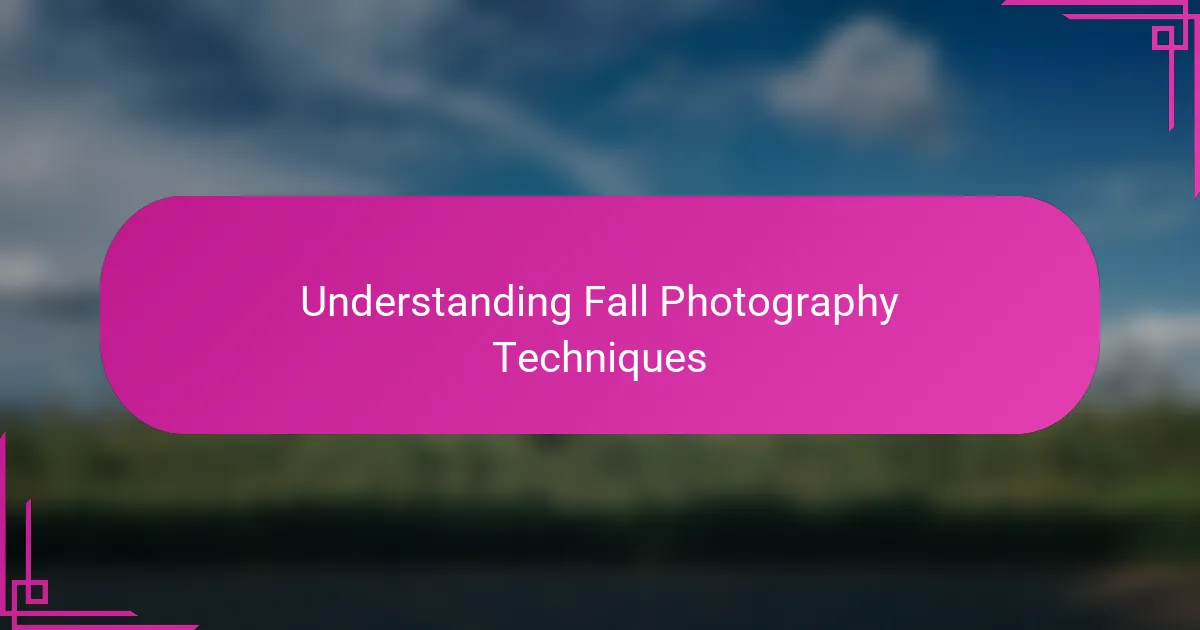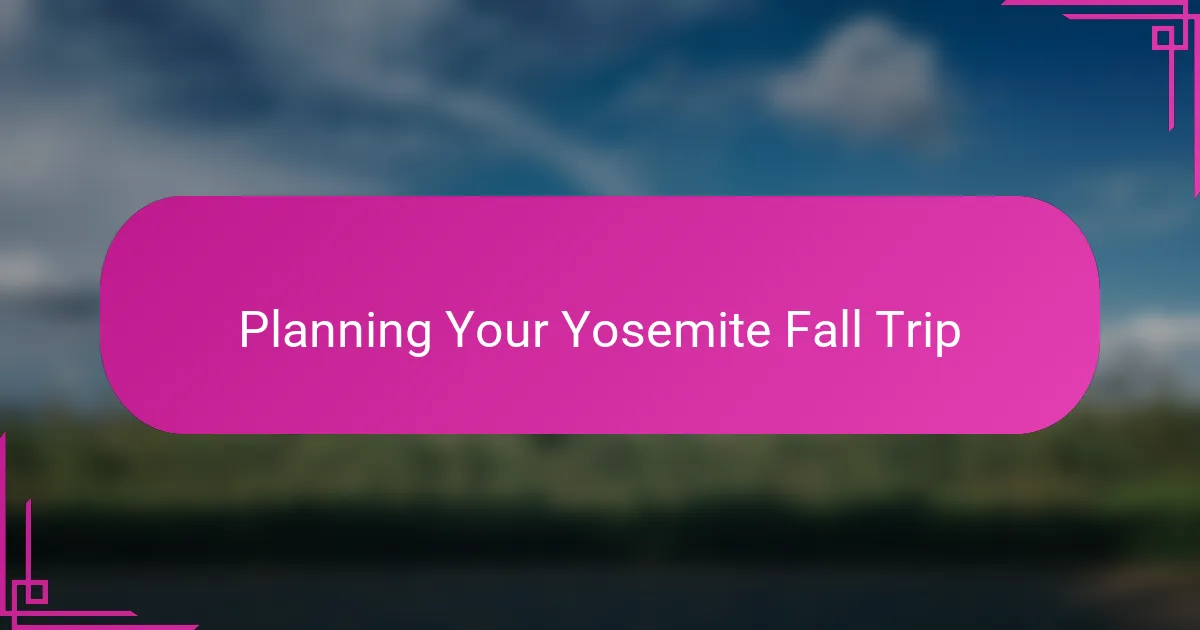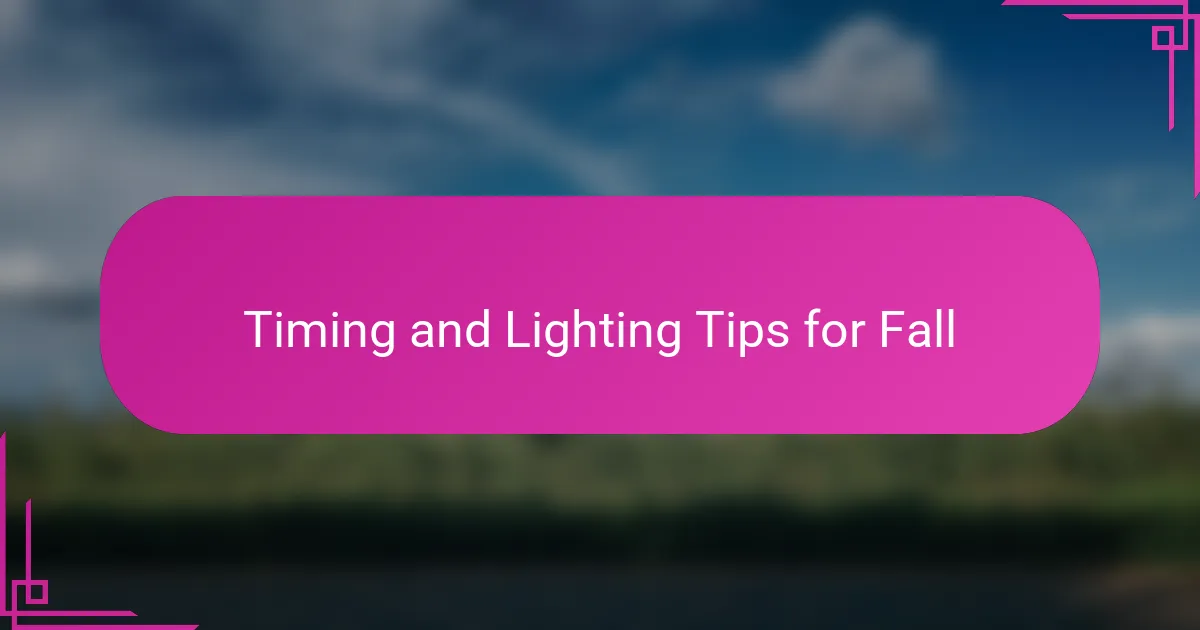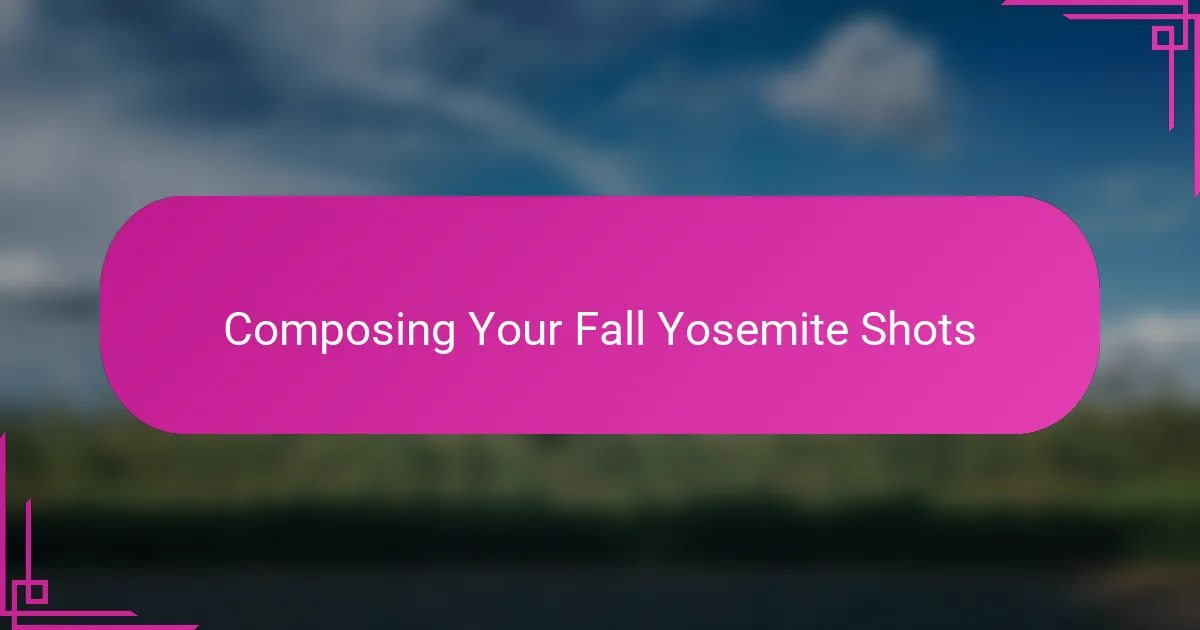Key takeaways
- Utilize soft, golden light during “golden hour” for depth and richness in fall photography.
- Plan your Yosemite trip carefully, focusing on peak foliage timing and mapping out locations for optimal shooting.
- Incorporate various lenses and tripods in your gear to capture diverse perspectives and ensure stability during low-light conditions.
- Keep post-processing simple to enhance colors and textures while preserving the authentic feel of the fall environment.

Understanding Fall Photography Techniques
Mastering fall photography means truly tuning into the season’s unique qualities. Have you noticed how the warm, golden light of autumn afternoons seems to wrap around everything? That soft, directional light is a game-changer—it adds depth and richness to colors that can otherwise look flat in midday sun.
From my experience, embracing slower shutter speeds during this time can bring out the subtle motion of falling leaves, creating a dynamic feel without losing sharpness. But balancing exposure is tricky when the contrast between shadows and highlights is stark—what’s your approach for handling those challenging lighting conditions?
And then there’s composition: placing vibrant leaves against contrasting backgrounds—not just sky or water, but maybe weathered bark or moss—can transform an ordinary shot into something memorable. Have you tried experimenting with different perspectives or focal lengths to capture that fall essence more vividly? For me, it’s always about layering textures and colors to invite the viewer into the scene.

Planning Your Yosemite Fall Trip
Planning your Yosemite fall trip starts with timing—it’s all about catching the peak foliage before the leaves let go. From my experience, mid to late October usually delivers the richest colors, but the weather can be tricky, so I always check the latest reports and fall foliage trackers. Have you ever found yourself arriving just a week too early or too late? It’s a bit heartbreaking, but that’s part of the adventure.
I’ve learned that booking accommodations months ahead is crucial because Yosemite fills up fast during fall. It’s tempting to wait for last-minute deals, but in my case, that gamble led to camping spots being fully booked and some long drives each day. For me, having a comfortable base nearby was key to staying energized for early morning shoots.
One thing I never overlook is mapping out locations I want to visit. Yosemite’s vast, and with limited daylight, I’ve found planning routes between spots like Glacier Point and Valley Floor saves precious time. Do you recall a trip where you spent more time wandering than shooting? I bet careful route planning can turn your day from rushed to relaxed—and your photos will thank you.

Essential Gear for Fall Photography
When I head out for fall photography in Yosemite, my camera body and a couple of reliable lenses are my absolute must-haves. A wide-angle lens helps me capture those sweeping landscapes filled with fiery leaves, while a macro lens lets me get up close with intricate details like dew-covered spiderwebs or crisp leaves. Have you ever missed a shot because you were stuck with just one lens? I know I have, and it’s a frustrating feeling.
Tripods are another piece of gear I never skimp on during fall. The soft, waning light often means longer exposures, and having a sturdy tripod keeps my shots sharp and steady, especially when I’m experimenting with motion blur of swirling leaves. Plus, it frees up my hands to adjust settings or even sip a warm drink while waiting for the perfect moment. Trust me, it’s worth the extra weight in your pack.
Lastly, I always pack a set of polarizing filters. They’re fantastic for reducing glare on wet leaves and enhancing the saturation of colors—those reds, golds, and oranges just pop in a way that feels alive. Have you noticed how much difference a good polarizer can make? It’s like giving your photos a little autumn boost without heavy editing.

Best Locations to Photograph in Yosemite
Glacier Point has always been my go-to spot for photographing Yosemite in the fall. From that vantage, the whole valley unfolds beneath you, framed by trees ablaze in autumn colors. Have you ever stood there as the late afternoon light turned the granite cliffs golden? It’s honestly one of those moments that makes the early wake-up calls totally worthwhile.
Then there’s the Valley Floor, which offers a completely different vibe. I’ve spent hours wandering the meadows and alongside the Merced River, finding quiet pockets where the falling leaves gather like natural confetti. What I love about this area is how the reflections add a painterly quality to the shots, especially when the water’s calm in the crisp fall air.
And I can’t forget about Tuolumne Meadows. It’s a little off the beaten path but so worth the drive. The open spaces combined with distant mountain backdrops let you play with scale and depth in your images. I remember one chilly morning when the fog was just lifting, and those golden aspen groves looked almost surreal—capturing that felt like catching a secret Yosemite was sharing only with me.

Timing and Lighting Tips for Fall
Timing is everything when photographing Yosemite in fall. In my experience, sunrise and the hour before sunset cast the most magical light, bathing the landscape in warm, golden hues that make the autumn colors truly sing. Have you ever stayed up early or lingered late just to chase that perfect light? It’s a bit of a challenge but so rewarding when the scene comes alive.
Midday sun can be harsh and flatten those rich fall tones, so I usually avoid shooting then unless I’m after specific shadow details or textures. Instead, I focus on the soft, directional light during “golden hour” to add depth and drama. Sometimes, catching light filtering through thinning clouds creates a moody atmosphere that enhances the season’s vibe—have you found weather to be an unpredictable but inspiring partner in your shoots?
One tip I’ve picked up is to monitor how the light changes as the sun drops behind Yosemite’s granite walls. Often, those last fleeting moments reveal colors and contrasts you wouldn’t see otherwise. There’s something almost poetic about chasing fading light, knowing the perfect shot might disappear in minutes. Have you ever felt that electric mix of urgency and calm when the light shifts just right? That’s when fall photography, for me, feels like pure magic.

Composing Your Fall Yosemite Shots
When I’m composing my fall shots in Yosemite, I’m always looking for natural frames—branches heavy with golden leaves or rugged rocks that add texture and context. Have you ever paused to notice how a simple foreground element can pull a viewer into that vast landscape? It’s those little layers in the frame that give the image life beyond just pretty colors.
I’ve found that balancing the colorful foliage with strong shapes—like Yosemite’s towering granite cliffs—creates a striking contrast that grounds the composition. Sometimes, I’ll move around until the trees form a natural border or lead the eye toward a focal point. Does it ever surprise you how changing your position by just a few feet can completely transform the mood of a shot?
And then, there’s scale. Including something familiar, like a person or a hiking trail, helps convey the grandeur of Yosemite’s fall vistas. I remember one afternoon trying to capture a grove of glowing aspens with a tiny figure in the distance—suddenly, the vastness and quiet majesty of the scene hit me in a way that no solo tree could. Have you tried using scale to tell a story in your photos? It’s a simple trick but powerful for making images feel immersive.

Post Processing Your Fall Photos
Editing my fall photos is where the magic truly happens. Have you ever noticed how a slight adjustment in contrast or saturation can make those reds and golds pop like the crisp air of an autumn morning? From my experience, gently boosting the vibrance without overdoing it brings out the warmth of fall without making the image look unnatural.
I often spend time fine-tuning shadows and highlights to balance the dynamic range—the interplay of bright skies and shadowed forests can be tricky. Sometimes, I use selective editing tools to enhance the leaves’ texture while keeping the background soft, which adds depth and draws the eye right where I want it. Have you tried that subtle separation? It really makes the scene feel alive.
One thing I’ve learned is to keep post-processing simple and respectful to the original moment. Over-editing can drain the feeling of crisp autumn air and quiet stillness that’s so precious in Yosemite’s fall. Do you find that sometimes less really is more when editing? For me, preserving that authentic vibe is what makes each photo feel like a personal memory rather than just a pretty picture.